#african science
Explore tagged Tumblr posts
Text

#books#education#black history#blackherstory#study#critical reading#moors#moorsinspain#thesagittarianmind#black power#black liberation#blackcivilization#african technology#African civilization#african science#african spirituality#african power#african studies#african literature#black men#black women#thesagitt
49 notes
·
View notes
Text
Why Are All Humans Unique? Meiosis: Crash Course Biology #30
youtube
Dr. Sammy is my best Black Indigenous Scientist in the world even though I am much older than he. We are going to talk about sex because most of the world is scientific illiterate and this is something that is shared by most Black Scientists worldwide.
Black Scientists hate being called the so-called white people world, but let me be the first to tell you that science is Black and African, the so-called white people took science and made it to be in their own image.
Some of us are coming up with a new creative Way to teach science today by destroying everything that resembles whiteness, simply because whiteness is a myth and it needs destroying.
Let's get back to the video topic today, which is all about sex and our natural world of Black Indigenous People globally because we are the children of the sun and every human on our planet comes from our Black African skin.
#black love#black positivity#black africans#black history#science#black scientist#black science#African Science#Youtube
2 notes
·
View notes
Text

Behold the beautiful Great Blue Turaco (Corythaeola cristata)! Growing up to 30 in (76.2 cm) long, this forest-dwelling bird can be found in parts of Central and West Africa such as Uganda and Guinea. It feeds on a diet that includes fruits, leaves, and insects. While it isn’t a long-distance flier, this bird uses its wings to flutter through the trees—rarely descending to the ground. It can most often be spotted in small groups.
Photo: Nik Borrow, CC BY-NC 4.0, iNaturalist
#science#nature#natural history#animals#fact of the day#did you know#birds#ornithology#turaco#africa#african birds#cool animals#fun facts
785 notes
·
View notes
Text
Proteles cristata
Throughout history, there have been two types of hyenas: bone-crushing hyenas, and dog-like ones. Spotted, striped, and brown hyenas are the bone-crushing type. Of the dog-like hyenas, the aardwolf is the only species left.
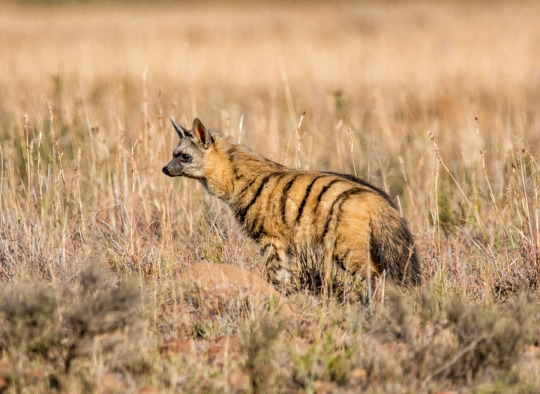
Aardwolf means "Earthwolf" in Afrikaans, a language spoken in Southern Africa. Their use of burrows is what earned them the "earth" part of their name. Although wolf is also in its name and it looks very dog-like, aardwolves are not canines. They are the smallest of four hyena species, weighing around 20 pounds (9.07 kg).
Unlike the other hyena species that eat carrion, aardwolves eat insects. If they really need to they can also eat eggs, small mammals, and vegetation, but insects are preferred. Their main insect prey is termites, and they can eat up to 300,000 of them in one night using their long tongues. Their tongues are very sticky as well, with large papillae (those little tongue bumps) and sticky saliva.
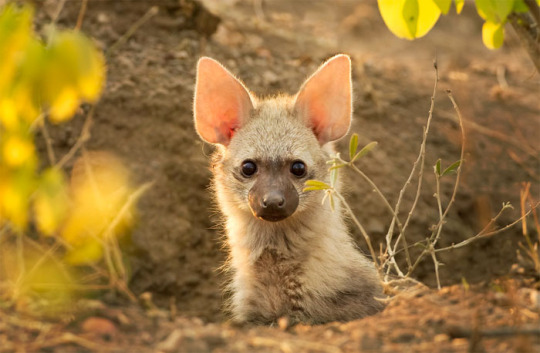
Since they behave differently and are much smaller than other hyena species, scientists used to think aardwolves were not part of the hyena family. With their striped coats, researchers thought they might have even been mimicking the striped hyena.
Aardwolves are found in arid plains of eastern and southern Africa, where they live in burrows dug by aardvarks, springhares, or porcupines. Some dig their own burrows, but taking over an abandoned one is much easier. They sleep in these burrows during the day, coming out at night to hunt for insects and to hang out with friends or whatever.
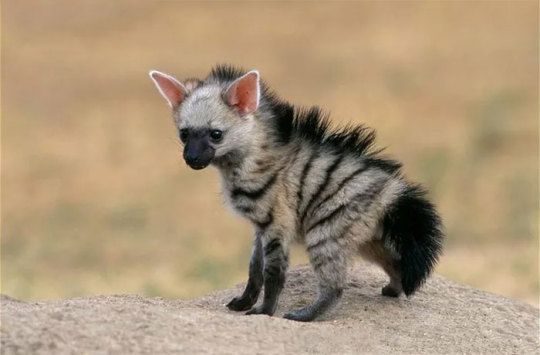

I rate the Aardwolf 15/10. Little cuties :,)
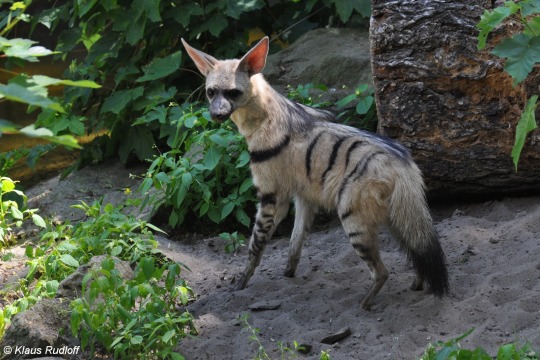
Photo Credits:
(1) Catherine Withers-Clarke (2) Hennie van Heerden (3) H. van den Berg (4) Scott Roberts (5) Klaus Rudloff
#aardwolf#CUTEEEEEEE#little guys#earthwolf#hyena#aardwolves#hyaena#biology#zoology#animals#science#nature#wildlife#african animals#cute animals#animals u should know about#miniature hyena
2K notes
·
View notes
Text
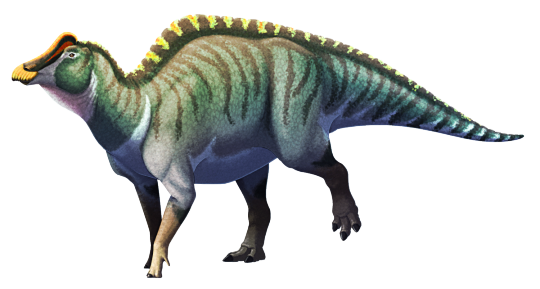
For a long time there were no hadrosaurid fossils known from Africa.
This seemed to mainly be due to the limits of the geography of their time. Hadrosaurs evolved and flourished during the late Cretaceous, when Africa was isolated from all the other continents, and they didn't seem to have ever found their way across the oceanic barriers.
…Until in 2021 a small hadrosaur was discovered in Morocco, a close relative of several European species, showing that some of these dinosaurs did reach northwest Africa just before the end of the Cretaceous - and with no land bridges or nearby island chains to hop along, they must have arrived from Europe via swimming, floating, or rafting directly across several hundred kilometers of deep water.
And now another hadrosaur has just been described from the same time and place.
Minqaria bata lived in Morocco at the very end of the Cretaceous, about 67 million years ago. Only known from a partial skull, its full appearance and body size is unknown, but it probably measured around 3.5m long (~11'6") – slightly larger than its previously discovered relative, but still very small for a hadrosaur. It might represent a case of insular dwarfism, since at the time Morocco may have been an island isolated from the rest of northwest Africa.
Along with its close relative Ajnabia, and at least one other currently-unnamed larger hadrosaur species, Minqaria seems to be part of a rapid diversification of hadrosaurs following their arrival in Morocco, adapting into new ecological niches in their new habitat where the only other herbivorous dinosaur competition was titanosaurian sauropods, and the only large predators were abelisaurs.
If the K-Pg mass extinction hadn't happened just a million years later, who knows what sort of weird African hadrosaurs we could have ended up with?
———
NixIllustration.com | Tumblr | Patreon
#science illustration#paleontology#paleoart#palaeoblr#minqaria#hadrosaur#hadrosauridae#ornithopod#ornithischia#dinosaur#art#insular dwarfism#african hadrosaurs!
449 notes
·
View notes
Text
The first dead elephants were discovered in May 2020. By July of that year, over 350 of the endangered animals had been found strewn lifeless across a remote region of Botswana. Global concern rose rapidly as veterinarians at the scenes eliminated the usual suspects. There were no signs of starvation, infections, or naturally occurring anthrax, and the giant mammals' tusks were still intact, ruling out poaching. Some of the elephants were found face down, suggesting a sudden collapse. That left one prime suspect, toxic cyanobacteria – also known as blue-green algae – which now, four years later, a new study led by King's College London supports.
Continue Reading.
#Science#Animals#Environment#Biology#Loxodonta Africana#African Bush Elephant#Elephants#Climate Change#Botswana#Southern Africa
112 notes
·
View notes
Text
Mooing crocodiles
Some interesting news on croc vocalisation I completely forgot to talk about. A recent paper on the West African Dwarf Crocodile (Osteolaemus tetraspis) revealed a before unknown diversity in noises it is able to produce. By recording captive animals and comparing the noises made by them to recordings suspected to be those of wild individuals, researchers could identify FOUR new types of calls not seen previously in crocodilians.
These calls range from low frequency sounds like "drums" (short) and "rumbles" (long) to more higher frequency sounds like "gusts" and what the scientists refer to as "moos".
Though the paper itself didn't include sound files (to my knowledge), you can hear the "mooing" sound and some others around the 16 minute mark in this here podcast Podcasts | Weekly: Antimatter falls down; Virtual healthcare comes with a price; What’s causing Europe’s insect apocalypse? | New Scientist
Croc vocalisation is a generally underappreciated field of research that usually gets little attention, no doubt because many pass of crocodiles as silent animals when really they can be quite vocal and have a surprisingly broad range, small forms like the dwarf crocodiles especially. This can even be seen in this study, as the wild sounds were only recorded on "accident" by a study focused on elephants.
Also for those unfamiliar with dwarf crocodiles, here's an image of one.
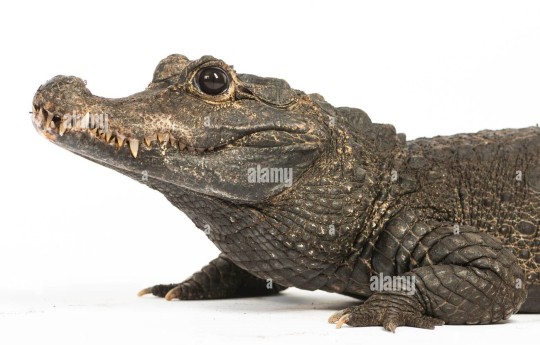
#dwarf crocodile#west african dwarf crocodile#crocodile#crocodilia#osteolaemus#osteolaemus tetraspis#vocalisation#mooing crocodile#science#herpetology#croc
429 notes
·
View notes
Text

AFRICAN PENGUINS IDENTIFY PATNERS BY THEIR CHEST DOTS
Birds are known to be highly social and visual animals, and penguins are not the exception, as they live in dense colonies. Yet no specific visual feature has been identified to be responsible for individual recognition in birds. Now, researchers demonstrate that african penguins (Spheniscus demersus) can recognize their each others using their ventral dot patterns.
Researchers placed a experiment at the Zoomarine Marine Park, in Rome, Italy, to test how penguins will react to a model with plain with no dot penguin, and to penguins with dots, to find out penguins actually could visually recognize the dots of their lovers and friends in the zoo.
Penguins rely strongly on their ventral dot patterns for individual recognition, and may have holistic representations of other penguins in the colony. In this video below, an african penguin named Gerry appears to recognize his mate, Fiorella (left), in an individual recognition experiment.
These findings suggest that african penguins may rely on a more holistic visual representation of their partner, which includes both the ventral dot patterns and their partner's facial features. Notably, these abilities are not dependent on the ability of a pair to produce offspring together. Nemo and Chicco, male partners, showed the same preference for each other as other penguin partner pairs, suggesting that the ability to distinguish the partner from others is driven simply by the special bond developed between nesting partners.
Photo: Few members of the Zoomarine Italia penguin colony. Unique ventral dot patterns are visible on each penguin's chest. Photo: Cristina Pilenga.
Baciadonna et al., 2024. African penguins utilize their ventral dot patterns for individual recognition. Animal Behaviour.
#Spheniscus demersus#Spheniscus#spheniscidae#african penguin#penguins#science#marine science#ethology#biology#marine biology#bioblr#sciblr#scienceblr#sciencie#science side of tumblr
203 notes
·
View notes
Text
today's gay animal of the day is...

african lions!
did you know that one of the lions in that photo is female? some african lionesses have been observed displaying typically male lion behaviors and appearances, such as growing manes, regularly scent-marking, roaring, aggressively protecting their prides (heh), and mounting other females
76 notes
·
View notes
Text
#good news#science#nature#environmentalism#environment#animals#conservation#rhinos#white rhino#africa#african white rhino
366 notes
·
View notes
Text
Animal of the Day!
West African Lungfish (Protopterus annectens)
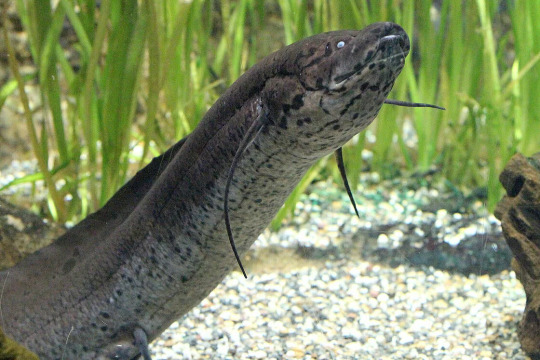
(Photo from Zoo Leipzig)
Conservation Status- Least Concern
Habitat- Western Africa; Southern Africa
Size (Weight/Length)- 3.6 kg; 100 cm
Diet- Mollusks; Frogs; Fish; Roots; Seeds
Cool Facts- The West African lungfish have one of the most complex respiratory systems of any fish. Capable of breathing air with help from gas bladders, they can maximize their gas exchange in their lungs. Even when water is abundant, West African Lungfish breathe directly from the surface. However, living in Africa often means a lack of water for most of winter. These lungfish are capable of living outside of water for these months, buried in dry riverbeds and waiting for the rains to bring rivers. During their aestivation, the West African lungfish doesn’t eat at all. One time, a lungfish survived 3 and a half years without eating anything as it waited for its river to fill.
Rating- 13/10 (Epitome of noodle arms.)
#animal of the day#animals#fish#lungfish#tuesday#august 15#west african lungfish#biology#science#conservation#the more you know
307 notes
·
View notes
Text

#books#education#worldview#african spirituality#africanmind#African philosophy#africanthought#study#reading#educate yourself#thesagittarianmind#african technology#african science#african studies#african literature#african power#african art
10 notes
·
View notes
Text
EUR0PE DID NOT CIVILIZED AFRICA - DR HENRIK CLARKE
youtube
My professor taught us well because he didn't believe in anything white, it's a social construct to empower themselves while destroying others. Weak men fear free and independent women, strong men only love and appreciate a strong Black Indigenous Woman who loves herself and her family and she will never tolerate her enemies and oppressors because for this type of Black Indigenous Lady, she will never allow herself to be used by the people who destroyed her beautiful Black Indigenous Family.
#black love#black positivity#black africans#black history#science#evolution#science side of tumblr#Youtube
124 notes
·
View notes
Text

Don’t let your roars go unheard this Election Day. Gather your pride and go out and vote! Did you know? Considered the most social of cats, lions live in prides that consist of one or more males, several females, and cubs. African lions breed at 3.5 years old, and the cubs are born spotted at birth. Adult male lions weigh about 375 pounds (170 kilograms), while females average 265 pounds (120 kilograms). See this diorama up close in the Museum’s Hall of African Mammals.
Photo: R. Mickens/ © AMNH
#science#amnh#museum#natural history#nature#animals#fact of the day#did you know#election day#lions#african lion#animal facts#cool animals#museum of natural history#cats#big cats
405 notes
·
View notes
Text
Parahyaena brunnea
Mostly due to habitat loss, brown hyenas are the rarest of the hyena species, with 4-10 thousand individuals in the wild. There are 30-50 thousand wild spotted hyenas, for comparison.
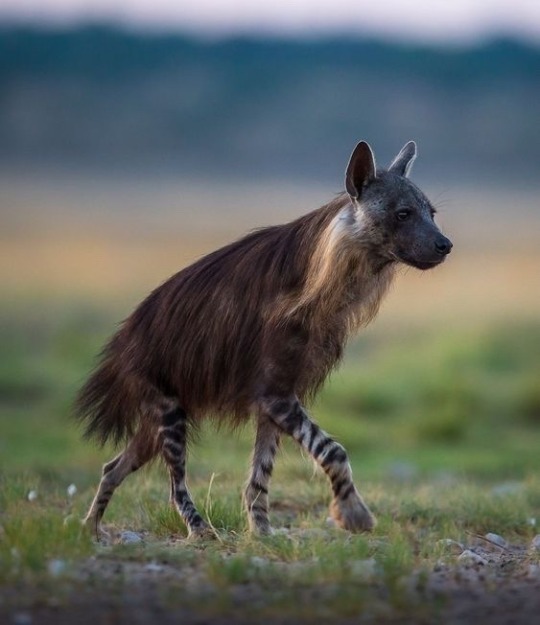
Brown hyenas are also known as strandwolves, which means "beach wolves" in Afrikaans, a language spoken primarily in South Africa. This name was given to them because brown hyenas in coastal areas spend a lot of time walking down beaches in search of food, and maybe to unwind after a long day. Some of the largest brown hyena populations are found in these coastal areas of Southern Africa, but there are also large populations in the Kalahari desert.
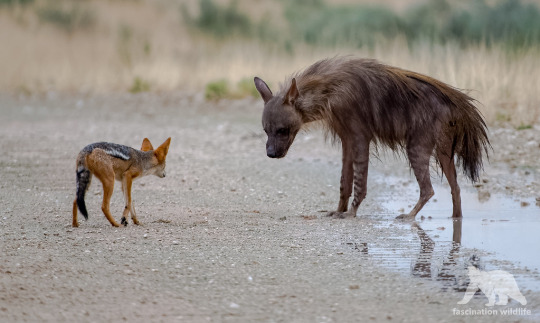
Although the name strandwolf suggests it, brown hyenas are not closely related to wolves or other canines. They can resemble canines, but hyenas are more closely related to cats than dogs. Their closest relatives are mongooses and civets. The photo below shows an African civet.
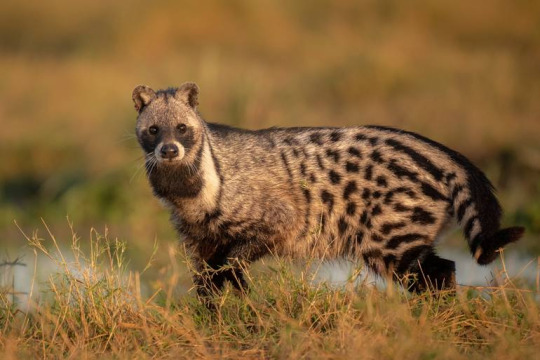
Brown hyenas are generally smaller than striped and spotted hyenas, but they can still get pretty big, weighing up to 90 pounds (40.8 kg). This size and their powerful jaws make them seem like formidable predators, but they're pretty bad hunters. They mostly scavenge for food or steal it from more capable hunters like cheetahs, leopards, and jackals. Since they can digest bones, hooves, horns, hair, and skin, they can basically eat every scrap food they find. Brown hyenas often live in groups, but this scavenging is done on their own.
Their clans are much smaller than those of spotted hyenas, and the structure is more similar to a wolf pack; most hyenas in the group are the offspring of the dominant hyenas. Brown hyenas are very social and form close bonds with other hyenas.
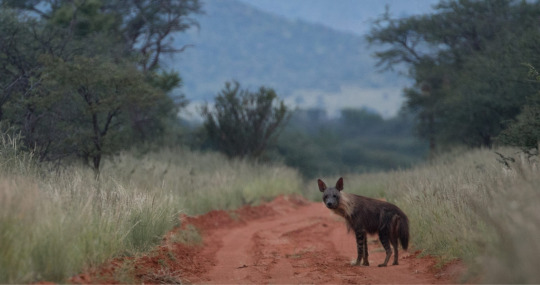
I rate the brown hyena 17/10. I like them. They seem a little bit lazy with their poor hunting skills and walks down the beach
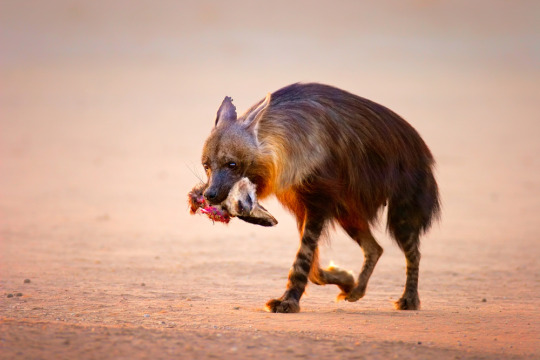
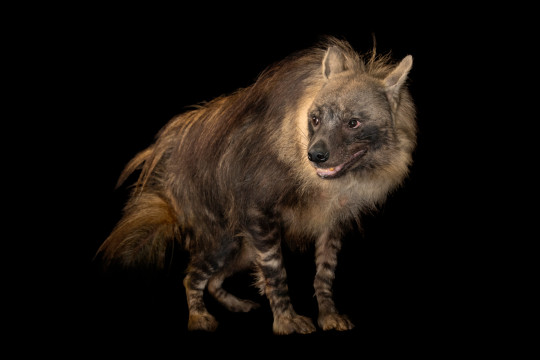
Photo credits:
(1) Christophe Jobic (2) Mario Nonaka (3) Yarin Klien (4) Thilo Beck (5) Johan Swanepoel (6) Joel Sartore
#brown hyena#brown hyenas#hyena#hyenas#animals#biology#nature#science#wildlife#zoology#animal#wild#african animals#hyaena#south africa#Africa
424 notes
·
View notes
Text
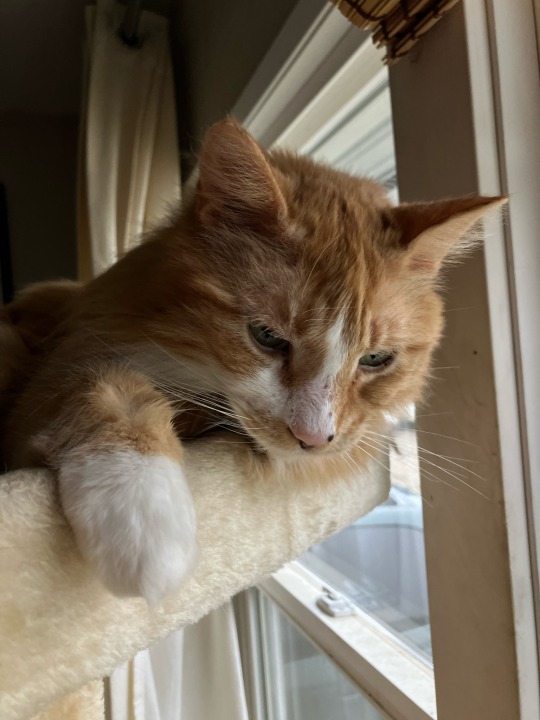
Despite being still fairly feral at thirteen years strong, my boy Casper the orange tabby floof displays multiple traits of domestication: bold white markings, long exquisitely soft hair, and an orange coat which would only ever rarely ever occur in the wild. Also, allergies.
There Was Another Domestic Cat!
I hate that I'm only now in 2024 learning about this rad 2016 cat science find (frustrating that it wasn't more publicized,); there's evidence in China that there was once a second species of domestic cat, Prionailurus bengalensis, or the Asian Leopard Cat. Fellow cat nerds will recognize that this is the same wild species that was hybridized with the domestic cat to produce the famously active and beautiful breed known as the bengal cat, however these ancient domestic cats evidenced in the study share no relation to the modern bengal. Modern domestic cats notably descend from the African wildcat (Felis silvestris lybica.)
The evidence of the domesticated version of the Asian Leopard cat is primarily wear patterns on teeth still connected to jaw bones found in China which do not show up in fully wild kitties. This basically means that these domestic cats were eating a diet which their wild brethren do not consume.
To me, the idea of a second ancient species of domestic cat is extremely intriguing and I will most definitely need to draw a concept if what these cats would have looked like with the calling card bold white markings and other domestic traits which inevitably appear in domesticated animals, as shown in the Russian Silver Fox Project which eventually produced completely domesticated foxes. It would also be very interesting scientifically to see the full ancient domestication of the Asian Leopard Cat reproduced although with thousands of modern domestic kitties in need of homes this experiment is likely never going to happen (which is for the better with so many far more suitable modern purr machines available for adoption.)
Domestication of modern domestic cats (Felis silvestris catus/Felis catus) likely took place on the Mediterranean island of Cyprus some 10,800 years ago with the cats quickly spreading to Egypt and China where they became beloved fixtures of temples, homes and palaces. Today thanks to artificial selection these kitties exist in miriad beautiful breeds and coat patterns but more importantly, modern kitties are noble, affectionate, and extremely social companions of the educated, responsible human household.

My three year old blue tuxedo cat Keplar, who spends his days playing, following me around everywhere that he can (getting very frustrated when he cannot,) chatting with me, and snuggling with his thirteen year old unrelated fluffy orange tabby brother, Casper. With a dilute gene turningwhat would've been a melanistic coat grey and bold white markings which are found only in domesticated animals, Keplar is an excellent representative of the modern domestic cat.
#cats#cats of tumblr#kitties#domestic cat#house cat#cat#cat news#cat science#asian leopard cat#bengal cat#african wildcat#archaeology#Chinese archaeology#Prionailurus bengalensis#Felis silvestris lybica
22 notes
·
View notes